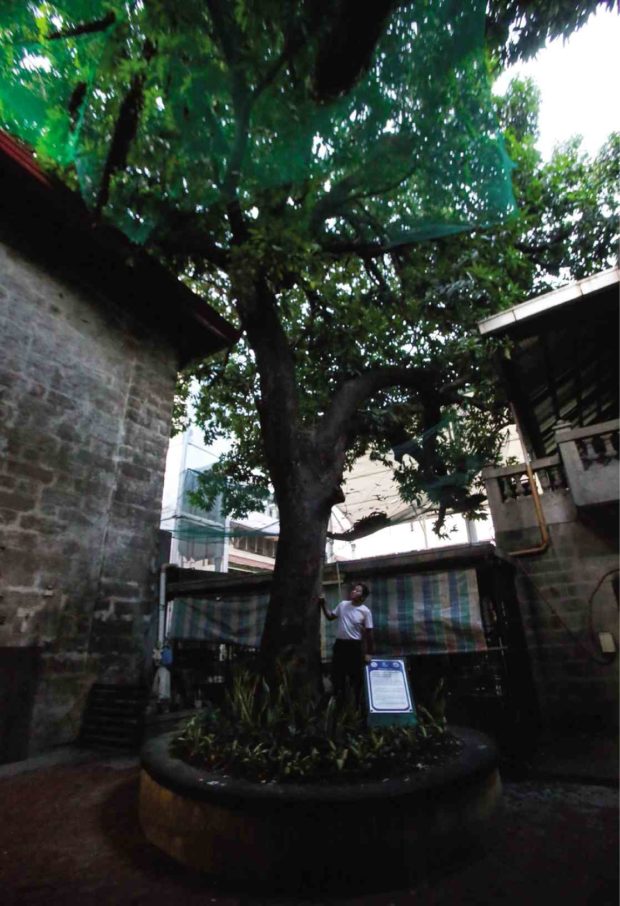Protection assured for the last ‘Lolo’ standing in Pateros

Credit to Author: racosta| Date: Sat, 06 Jul 2019 21:11:46 +0000
MANILA, Philippines — Many worshippers at San Roque Parish church in Pateros come and go without knowing that they have encountered one of the oldest “living legends” in the lone Metro Manila municipality.
Town elders, however, are ever aware of the significance of “Lolo Mango,” the mango tree they have fondly named at Barangay Poblacion that residents believe is already more than 100 years old.
‘Tall and mature’
Grandparents in the neighborhood who are in their late 70s to 90s recall that the tree was already standing “tall and mature” in the churchyard as early as the 1930s.
With the town now urbanized, the elders are worried that Lolo Mango would become another casualty of modern development. They remember how several acacia trees — considered much older than Lolo — were cut down years ago to give way to a school building.
“They [the acacias] would have been much bigger now and providing us shade had they been spared,” Nelia Flores, 78, said.
Heritage tree
Their fears were allayed recently, however, after the Department of Environment and Natural Resources (DENR) declared Lolo Mango as Metro Manila’s 28th “heritage tree.”
On June 5, the DENR-National Capital Region office, led by Regional Director Jacqueline Caancan, and the San Roque Parish Church represented by Fr. Jorge Jesus Bellosillo, signed a memorandum of agreement to protect and nurture the tree. A marker was also installed for the occasion.
In 2009, the DENR launched the Heritage Tree Program in Metro Manila, “to avert the effects of climate change” on what remains of the capital’s greenery while “enhancing biodiversity in the urban forest ecosystem.”
‘Historic value’
Under the program, the area around a heritage tree — at least five meters from the edge of its crown — is declared a tree protection zone. Pruning, cutting or removing a heritage tree — and any work done near its protection zone — requires permission from the DENR.
But with or without the heritage marker, the seniors of Pateros said they were ready to protect Lolo Mango “for as long as we live and after.”
“He has always been taken for granted, especially by the young. But we will not forget,” said Flores, a parish pastoral council coordinator at San Roque.
Oral accounts provided by Flores and fellow seniors were used as basis by the local government to prove Lolo Mango’s “historic value” and to recommend its declaration as a heritage tree.
For 91-year-old Esteli Raymundo, Lolo Mango evoked fear and respect in her youth. In the early 1930s, she recalled, she and her friends were often warned by their parents not to play near the tree lest they disturb the “supernatural being” that supposedly guarded it.
In World War II, the church was converted into a garrison by the Kempeitai, the dreaded military police of the invading Japanese army.
Local lore
Men suspected of spying for the Americans were tortured there, according to the stories handed down to Flores and her peers. Local lore spoke of Pateros having its share of collaborators—or “makapili”—during the war, and it was in the church that they pointed a betraying finger at fellow Filipinos.
“It’s a painful part of history that we wish we would not talk about because no one knew what really happened inside. If there’s anyone still alive to tell this horrific tale, it would probably be Lolo Mango,” Flores said.
For Ester Santa Ana, 82, the mango tree is a symbol of romance.
“It was under [Lolo Mango] where my former high school classmates Angelita Bautista and Freddie Cruz fell for each other,” she recalled. “The mango tree was their ‘hintayan and tagpuan’ [trysting place], and where they played ‘habulan’ [tag].”
Last living treasures
The childhood sweethearts eventually married and lived a good life in Canada, Santa said of her friends.
The residents hoped that having Lolo Mango declared as a heritage tree would encourage their town mates, especially the youth, to protect one of their last living treasures.
“The young people may not care because they don’t know their history,” Flores said, “But we, the old-timers, are here and we are ready to tell them that Lolo Mango is not an ordinary mango tree but a living witness to the history of Pateros for more than a century.”